Dual role of nNOS in ischemic injury and preconditioning
- PMID: 20707900
- PMCID: PMC2927582
- DOI: 10.1186/1472-6793-10-15
Dual role of nNOS in ischemic injury and preconditioning
Abstract
Background: Nitric oxide (NO) is cardioprotective and a mediator of ischemic preconditioning (IP). Endothelial nitric oxide synthase (eNOS) is protective against myocardial ischemic injury and a component of IP but the role and location of neuronal nitric oxide synthase (nNOS) remains unclear. Therefore, the aims of these studies were to: (i) investigate the role of nNOS in ischemia/reoxygenation-induced injury and IP, (ii) determine whether its effect is species-dependent, and (iii) elucidate the relationship of nNOS with mitoKATP channels and p38MAPK, two key components of IP transduction pathway.
Results: Ventricular myocardial slices from rats and wild and nNOS knockout mice, and right atrial myocardial slices from human were subjected to 90 min ischemia and 120 min reoxygenation (37 degrees C). Specimens were randomized to receive various treatments (n = 6/group). Both the provision of exogenous NO and the inhibition of endogenous NO production significantly reduced tissue injury (creatine kinase release, cell necrosis and apoptosis), an effect that was species-independent. The cardioprotection seen with nNOS inhibition was as potent as that of IP, however, in nNOS knockout mice the cardioprotective effect of non-selective NOS (L-NAME) and selective nNOS inhibition and also that of IP was blocked while the benefit of exogenous NO remained intact. Additional studies revealed that the cardioprotection afforded by exogenous NO and by inhibition of nNOS were unaffected by the mitoKATP channel blocker 5-HD, although it was abrogated by p38MAPK blocker SB203580.
Conclusions: nNOS plays a dual role in ischemia/reoxygenation in that its presence is necessary to afford cardioprotection by IP and its inhibition reduces myocardial ischemic injury. The role of nNOS is species-independent and exerted downstream of the mitoKATP channels and upstream of p38MAPK.
Figures
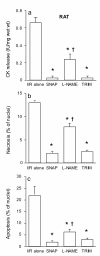
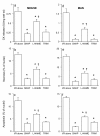
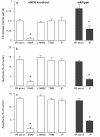
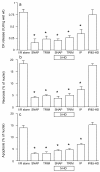
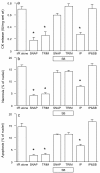
Similar articles
-
Modulation of the nitric oxide metabolism overcomes the unresponsiveness of the diabetic human myocardium to protection against ischemic injury.J Surg Res. 2011 Dec;171(2):452-6. doi: 10.1016/j.jss.2010.07.040. Epub 2010 Aug 15. J Surg Res. 2011. PMID: 20869072
-
The opposite roles of nNOS in cardiac ischemia-reperfusion-induced injury and in ischemia preconditioning-induced cardioprotection in mice.J Physiol Sci. 2009 Jul;59(4):253-62. doi: 10.1007/s12576-009-0030-1. Epub 2009 Mar 4. J Physiol Sci. 2009. PMID: 19340535 Free PMC article.
-
Contribution of Akt and endothelial nitric oxide synthase to diazoxide-induced late preconditioning.Am J Physiol Heart Circ Physiol. 2004 Sep;287(3):H1125-31. doi: 10.1152/ajpheart.00183.2004. Epub 2004 May 13. Am J Physiol Heart Circ Physiol. 2004. PMID: 15142844
-
Protection of the ischaemic heart: investigations into the phenomenon of ischaemic preconditioning.Cardiovasc J Afr. 2009 Jan-Feb;20(1):43-51. Cardiovasc J Afr. 2009. PMID: 19287816 Free PMC article. Review.
-
Cardioprotective function of inducible nitric oxide synthase and role of nitric oxide in myocardial ischemia and preconditioning: an overview of a decade of research.J Mol Cell Cardiol. 2001 Nov;33(11):1897-918. doi: 10.1006/jmcc.2001.1462. J Mol Cell Cardiol. 2001. PMID: 11708836 Review.
Cited by
-
Roles of endothelial nitric oxide synthase (eNOS) and mitochondrial permeability transition pore (MPTP) in epoxyeicosatrienoic acid (EET)-induced cardioprotection against infarction in intact rat hearts.J Mol Cell Cardiol. 2013 Jun;59:20-9. doi: 10.1016/j.yjmcc.2013.02.003. Epub 2013 Feb 16. J Mol Cell Cardiol. 2013. PMID: 23419451 Free PMC article.
-
Inhibitors of Src Family Kinases, Inducible Nitric Oxide Synthase, and NADPH Oxidase as Potential CNS Drug Targets for Neurological Diseases.CNS Drugs. 2021 Jan;35(1):1-20. doi: 10.1007/s40263-020-00787-5. Epub 2021 Jan 30. CNS Drugs. 2021. PMID: 33515429 Free PMC article. Review.
-
Cardioprotection of ischaemic preconditioning is associated with inhibition of translocation of MLKL within the plasma membrane.J Cell Mol Med. 2018 Sep;22(9):4183-4196. doi: 10.1111/jcmm.13697. Epub 2018 Jun 19. J Cell Mol Med. 2018. PMID: 29921042 Free PMC article.
-
Cardiometabolic health, menopausal estrogen therapy and the brain: How effects of estrogens diverge in healthy and unhealthy preclinical models of aging.Front Neuroendocrinol. 2023 Jul;70:101068. doi: 10.1016/j.yfrne.2023.101068. Epub 2023 Apr 13. Front Neuroendocrinol. 2023. PMID: 37061205 Free PMC article. Review.
-
Up-Regulation of Neuronal Nitric Oxide Synthase Expression by Cobalt Chloride Through a HIF-1α Mechanism in Neuroblastoma Cells.Neuromolecular Med. 2015 Dec;17(4):443-53. doi: 10.1007/s12017-015-8373-7. Epub 2015 Oct 12. Neuromolecular Med. 2015. PMID: 26458913
References
MeSH terms
Substances
LinkOut - more resources
Full Text Sources

